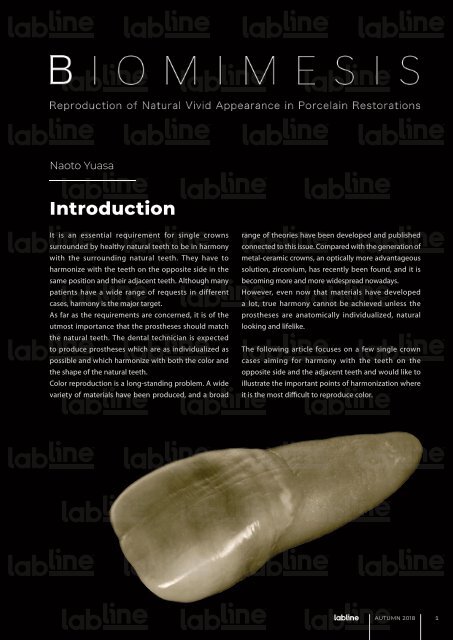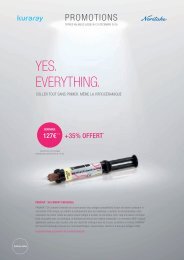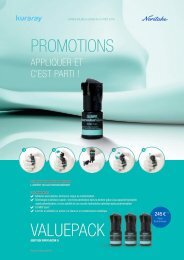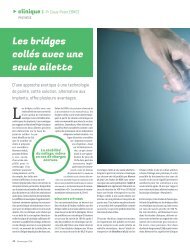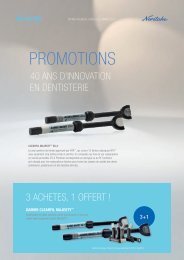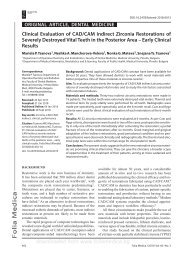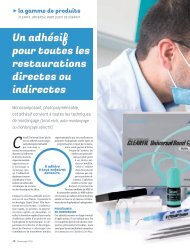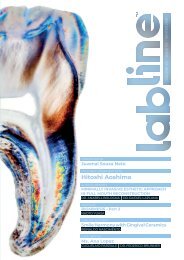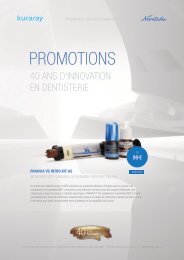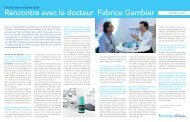Create successful ePaper yourself
Turn your PDF publications into a flip-book with our unique Google optimized e-Paper software.
<strong>Naoto</strong> <strong>Yuasa</strong><br />
Introduction<br />
It is an essential requirement for single crowns<br />
surrounded by healthy natural teeth to be in harmony<br />
with the surrounding natural teeth. They have to<br />
harmonize with the teeth on the opposite side in the<br />
same position and their adjacent teeth. Although many<br />
patients have a wide range of requests in different<br />
cases, harmony is the major target.<br />
As far as the requirements are concerned, it is of the<br />
utmost importance that the prostheses should match<br />
the natural teeth. The dental technician is expected<br />
to produce prostheses which are as individualized as<br />
possible and which harmonize with both the color and<br />
the shape of the natural teeth.<br />
Color reproduction is a long-standing problem. A wide<br />
variety of materials have been produced, and a broad<br />
range of theories have been developed and published<br />
connected to this issue. Compared with the generation of<br />
metal-ceramic crowns, an optically more advantageous<br />
solution, zirconium, has recently been found, and it is<br />
becoming more and more widespread nowadays.<br />
However, even now that materials have developed<br />
a lot, true harmony cannot be achieved unless the<br />
prostheses are anatomically individualized, natural<br />
looking and lifelike.<br />
The following article focuses on a few single crown<br />
cases aiming for harmony with the teeth on the<br />
opposite side and the adjacent teeth and would like to<br />
illustrate the important points of harmonization where<br />
it is the most difficult to reproduce color.<br />
AUTUMN 2018<br />
1
Materials<br />
In-Ceram Spinell (VITA) +<br />
Cerabien (Noritake)<br />
Description: Internal staining with Noritake Internal<br />
Stain Bright and White to control contrasting density. In<br />
order to create natural look, internal staining on dentin<br />
and enamel structure is applied separately.<br />
Materials<br />
KATANA Zirconia (Noritake) +<br />
Cerabien ZR (Noritake)<br />
Description: There is semi-dry condition in the incisal edge<br />
area due to slightly open lips in daily life. Characterization is<br />
done to match with the semi-dry condition.<br />
2<br />
AUTUMN 2018 AUTUMN 2018 3
Materials<br />
Metal + Noritake Super<br />
Porcelain EX-3 (Noritake)<br />
Materials<br />
KATANA Zirconia (Noritake) +<br />
Cerabien ZR (Noritake)<br />
Description: Margin porcelain was used in order to<br />
achieve the suitable sub-gingival condition of the<br />
marginal line. It is important to select a base color to<br />
match with the higher value in dentin structure and to<br />
pay attention to balancing the translucency between<br />
the central and lateral teeth since the lateral incisal has<br />
higher translucency on the incisal edge than the centrals.<br />
Staining on the cervical area should be avoided.<br />
Description: It is essential to pay attention to the contrast<br />
of the white band and the layer of the characterization<br />
because the target tooth has a lower contrast on white<br />
band area. In addition, there was a lower value on the<br />
incisal edge due to the enamel loss created by the facet<br />
angle. Special care was taken of creating a balance<br />
between translucency and low-value color.<br />
4<br />
AUTUMN 2018 AUTUMN 2018 5
Materials<br />
KATANA Zirconia (Noritake) +<br />
Cerabien ZR (Noritake)<br />
Description: In order to show clear mamelon structure<br />
with Internal Stain technique on the upper central,<br />
higher translucency on the incisal area was created with<br />
the help of base color construction. In case of the lower<br />
incisal and lateral teeth, their opacity was adjusted<br />
repeatedly on a quasi-abutment on the model, because<br />
the opacity, the translucency, the target shades and<br />
the layering techniques of porcelains were significantly<br />
affected by the color of the abutment.<br />
Materials<br />
KATANA Zirconia (Noritake) +<br />
Cerabien ZR (Noritake)<br />
Description: The situation is the same as in the<br />
previous case; there is only a thin layering space in the<br />
lower lateral. Therefore, layering is carefully done with<br />
serious consideration of the balance between the value<br />
of dentin structure and translucency.<br />
6<br />
AUTUMN 2018
Materials<br />
Materials<br />
KATANA Zirconia (Noritake) +<br />
Cerabien ZR (Noritake)<br />
Description: The target tooth has a flat texture on<br />
the facial surface and only orange color on the incisal<br />
area. A precisely simple characterization is necessary,<br />
and the result is immediately seen from the base<br />
color of the dentin structure and the color&thickness<br />
of the enamel structure.<br />
Metal + Noritake Supper<br />
Porcelain EX-3 (Noritake)<br />
Description: There is a quite large white area on the<br />
enamel of right upper central. It is necessary to have<br />
characterization of the dentin structure without<br />
surface characterization. During the internal staining<br />
of the enamel, a white area is made with Internal Stain<br />
White applying Dilution technique in order to create<br />
different varieties of contrast.<br />
8<br />
AUTUMN 2018 AUTUMN 2018 9
Materials<br />
KATANA Zirconia (Noritake) +<br />
Cerabien ZR (Noritake)<br />
Description: It is widely known that the layering<br />
methods of the anterior and posterior crowns<br />
are different due to the different thickness of<br />
the enamel structure. During posterior layering,<br />
bluish or grayish translucent color and whitish<br />
translucent color are present at the same time, and<br />
opalescence on the surface layer is necessary to<br />
have color designing.<br />
Materials<br />
KATANA Zirconia (Noritake) +<br />
Cerabien ZR (Noritake) on lower<br />
left 1st and 2nd pre-molar, Metal<br />
+ Noritake Supper Porcelain EX-3<br />
(Noritake) on both 1st molars<br />
Description: Description: This is a case of implantsupported<br />
single crowns. Once the articular layering<br />
method of molars is acquired, it is possible to use<br />
the same method for all the molar restorations<br />
with only a small adjustment of the base colors<br />
and balance. The important point of molar color<br />
matching is creating the enamel structure with<br />
translucent porcelain.<br />
10<br />
AUTUMN 2018 AUTUMN 2018 11
<strong>Naoto</strong> <strong>Yuasa</strong><br />
• 2002 Graduation from Toho Dental College<br />
• 2004 Graduation from Toho Dental College<br />
Advanced Program<br />
• 2004 Working at Kondo Dental Clinic<br />
• 2010 Working AS main ceramist in Otani Dental Clinic,<br />
Kuraray Noritake Dental International Instructor, Chairman<br />
of <strong>Yuasa</strong> Seminar<br />
Specials thanks to Dr. Ohtani for his<br />
continuous collaboration.<br />
12<br />
AUTUMN 2018


